
Modern lever-action shotguns like the Black Aces Pro Series L are few and far between, with pump-action models more prevalent. The reason for this, though, has far more to do with marketing than engineering.
Recently we received an e-mail inquiring about lever-action shotguns:
“Dear SI,” it read: “Are lever-action shotguns viable for self-defense and, if so, why aren’t there more of them in production?”
Before I attempt to answer this question, let’s begin with some history. Back in 1887, Winchester launched a John Browning-designed, lever-action shotgun—despite Browning’s protest that a slide-action shotgun would be better. (Exactly why he thought this is unclear.) Winchester, in wishing to keep to its lever-action roots, continued the project anyway. The resulting Winchester Model 1887 shotgun looked much like the company’s vaunted lever-action rifles, albeit with a pudgier receiver. It held five blackpowder shotshell rounds in its tubular magazine, plus one in the chamber. The top-loading, top-ejecting shotgun was offered in 12- and 10-gauge versions. In total, Winchester sold about 65,000 units.
Ten years later, Browning’s wishes came true when Winchester mass-produced his Model 1897 slide-action, hammered shotgun design that, in its short-barreled configuration, would come to be known as the Trench Gun thanks to its exploits in World War I. Although it sold more than 1 million units until its run ended in 1957, the ’97 was the precursor to the even-more-famous Model 12 hammerless pump-action shotgun that took the sporting world by storm. Largely forgotten was the fact that, back in 1901, Winchester updated its 1887 lever-action to safely fire smokeless-powder shells. But, because the company didn’t want to cut into sales of its 1897, it only produced the Model 1901 lever-action in 10 gauge. I suspect this is a big reason why the lever-action shotgun fell off in popularity; after all, the 1897 and Model 12 and Remington slide-actions in 12 gauge had become the gold standard, thus money was invested in refining them with such improvements as bottom loading and side ejection. As such, they were easier to load and less prone to jamming than the original 1887, thereby helping the 1887 into the unfortunate status of curio and relic.
Fast forward 120 years to the present, and only a few companies even offer lever-action shotguns. Of those, most are geared toward re-enactors and cowboy-action shooters (notably reproduction Model 1887s available from Chiappa, Taylor and Puma). Other companies, such as Henry and Marlin, offer modern, lever-action shotguns styled after their rifles, but these are chambered almost exclusively in .410-bore and therefore designed for small-game hunting.
Anecdotally, lever-action shotguns are knocked for their inferior reliability when compared to pump-actions, but some of this consensus is likely due to the limited number of modern lever-actions available with bottom-loading, side-ejection capabilities. Another factor could be due to shooters who are unfamiliar with them due to their rarity and/or shooters who have only fired them while at cowboy-action events.
However, there is at least one company importing and selling modern, 12-gauge lever-action shotguns for self-defense: Black Aces Tactical out of Florida. The company that actually inspired the birdshead-pistol-grip “firearm” trend (aka, the Mossberg Shockwave), Black Aces Tactical is a nimble shop on the cutting edge of tactical-shotgun technology. Its Pro Series L model features black or brown walnut furniture, matte or nickel metal finish, an 18.5-inch barrel, an extended six-round tubular magazine, an aluminum receiver, a 3-inch chamber, Benelli-style choke tubes, sling studs, a dovetailed receiver for mounting an optic and an overall weight of just 6.4 pounds. It’s shipped with robust bead-style metal sights, features a steel lever and loop and an action-connecting bar adjoined to the lever by a screw. Interestingly, it is shipped with a birdshead grip, which, when affixed, allows the shotgun to be easily stored in confined places like a boat, bag or bunk. Most incredibly, this bottom-loading, side-ejecting, defensive-style lever-action shotty retails for just $399.
Now, back to the gentleman’s question. In theory, an increased-capacity (for a shotgun), shorter-barreled lever-action shotgun such as the Pro Series L would be just fine—if not excellent—for defensive use. It is short, light, fast, compact, reliable, affordable and holds seven shotshells, total. While I have only fired the Pro-Series gun a few times, I found it fast, intuitive, well-balanced and reliable, provided you run the lever with vigor. It is streamlined, handles nicely and is well-suited for slug accuracy because the fore-end doesn’t wiggle when rested as it does on a pump-action. I do not prefer the left-side position of its safety because it’s difficult to reach for right-handers while in the shooting position, but other than that, the gun feels and functions great. Perhaps the biggest merit for such a lever-action shotgun? As witnessed in the film “Terminator 2: Judgement Day,” there’s just something Old-West-cool about them.
So yes, lever-action shotguns are viable for home defense provided they own modern defensive features and quality construction for unwavering reliability. Why aren’t there more of them, then? Perhaps John Browning was right and the slide-action is superior—but why he thought that remains a mystery. Sure, more round-cycling power can be generated with the left bicep pulling toward the body compared to the trigger hand flipping down and away, but is that enough to warrant the pump-action’s market domination? Technically both actions are sound and require very similar techniques to run them. Perhaps Winchester was wrong to only chamber its smokeless-power lever-action shotgun in 10-gauge. Who knows, maybe if the company had made a 12-gauge 1901 alongside its slide-action 1897, there’d be 10 million lever-action shotties in existence today. After all, there are scores of .30-30 Win. lever-action rifles in use right now, and few people ask, “Hey, where can I find a .30-30 pump?”
Sometimes that’s just the way the lever swings.




































